Many women’s football teams have been spending the past weeks back on the training ground and preparing for the new season, with coaches busy looking for hidden gems in the transfer market and finalising their tactics. Whilst most domestic campaigns have yet to begin, those teams who qualified for the 2022/2023 Women’s Champions League’s initial stages saw their first competitive action of the season last week, with plenty hoping for a long run in the competition.
The road to the final in Eindhoven began with the first qualifying round, which saw clubs put into four-team mini-tournaments and competing in a “semi-final” match and then either a “final” or a 3rd/4th playoff. Only the winners of the semi-finals and then the finals remained in the competition though, and two of those sides who met in a final were Ajax Vrouwen and Eintracht Frankfurt Frauen, who defeated Kristianstads and Fortuna Hjørring (the latter of whom lost manager Brian Sørensen to Everton Women this summer) respectively.
Both went into the match with a good chance of winning it, and, as this tactical analysis will show, it turned out to be an open game with both sides having opportunities to seal their place in the next round. The analysis will focus specifically on the importance of Ajax’s attacking tactics to their eventual win, most notably their pressing, as well as why Frankfurt benefitted from changes made at half-time but still ended up falling short.
Lineups

Ajax Vrouwen made just one change from their win over Kristianstads, with Soraya Verhoeve moving to the bench and Liza van der Most coming in, meaning that Isa Kardinaal switched to left-back for this one. Otherwise, head coach Suzanne Bakker opted for continuity, keeping the same team that defeated the Swedish side 3-1, meaning that Netherlands internationals Victoria Pelova and Sherida Spitse, who both featured for their country at Euro 2022, were again joined by Quinty Sabajo in the midfield whilst Romée Leuchter kept her place at the top of the pitch.
Eintracht Frankfurt Frauen also opted for a single change, having kept a clean sheet against 2021/2022 Danish runners-up Fortuna. Switzerland international Géraldine Reuteler was the one who dropped to the bench, with Slovenia striker Lara Prašnikar joining Germany’s Laura Freigang in a front two, whilst captain Tanja Pawollek switched to midfield from defence as Sjoeke Nüsken took up a new position on the right wing. Sophia Kleinherne moved to the centre of the defensive line, partnering Sara Doorsoun, with the new face in the XI being Anna Aehling, who started at right-back.
Ajax Vrouwen’s attacking tactics
Given that it was such an open and end-to-end game, taking control early on was always going to be critical, and it was Ajax Vrouwen who succeeded in striking first and putting their opponents under immediate pressure. As the match went on, both teams were guilty of squandering opportunities in the final third, but some excellent attacking tactics ensured that it was the Dutch side who managed to come through in the end.
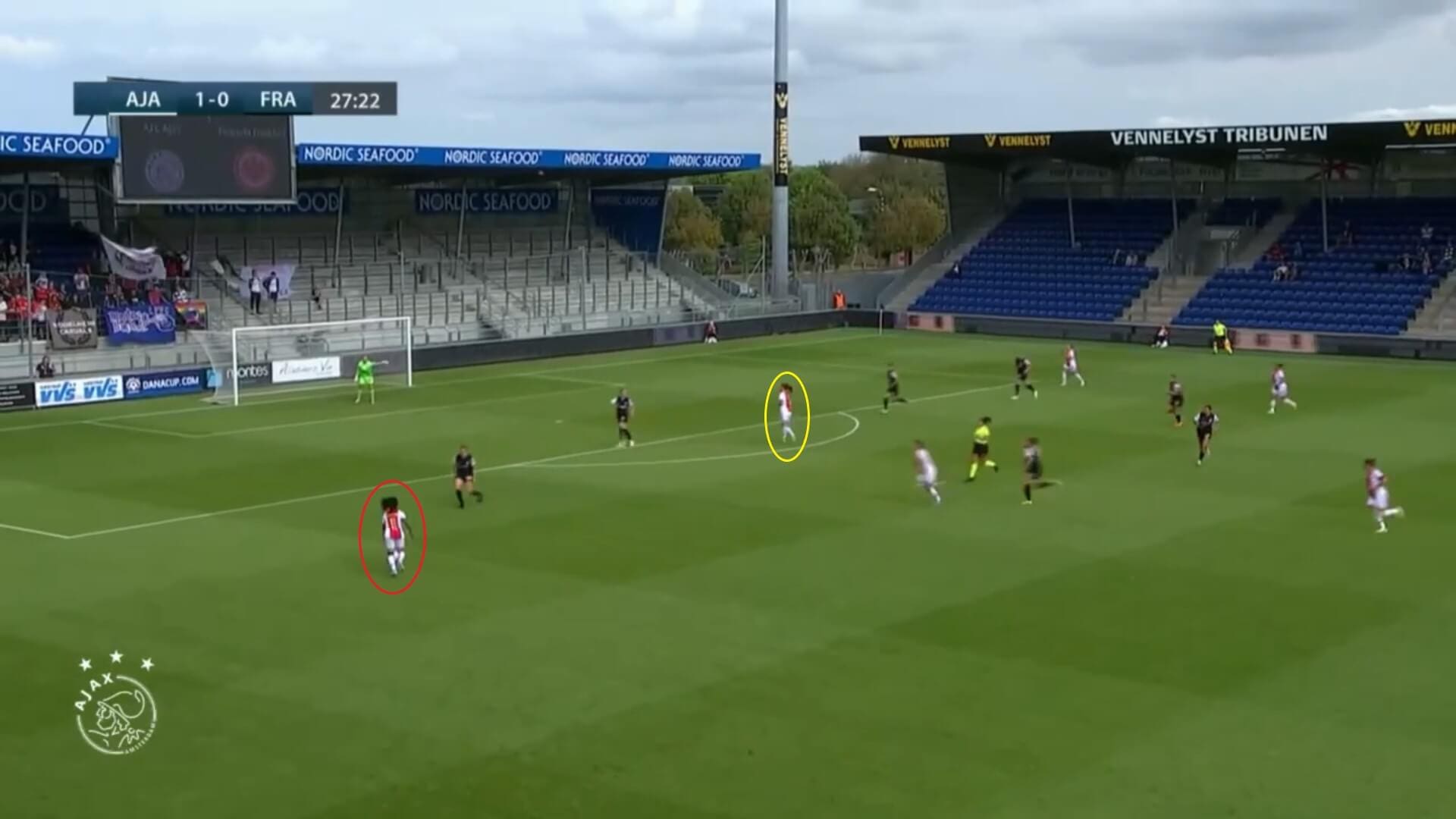
The basic structure of Ajax’s attack was to put Romée Leuchter in the middle of the final third, giving the team a target to find when in possession, using her to occupy the defenders whilst the pace on either side of her, coming from Ashleigh Weerden and Chasity Grant, helped to isolate the Eintracht Frankfurt Frauen defenders and occupy the space behind them.
However, the other critical factor that made this an effective setup was that Weerden and Grant never got too near to Leuchter, meaning that the Frankfurt players couldn’t narrow and had to stay apart from each other, leaving routes through to goal for Leuchter and others to attack into. If this is all put together, then it is clear that this attacking setup was a major reason for Ajax’s early control of the match, with Frankfurt unable to settle due to the constant switches in play and speed from the Ajax front three.
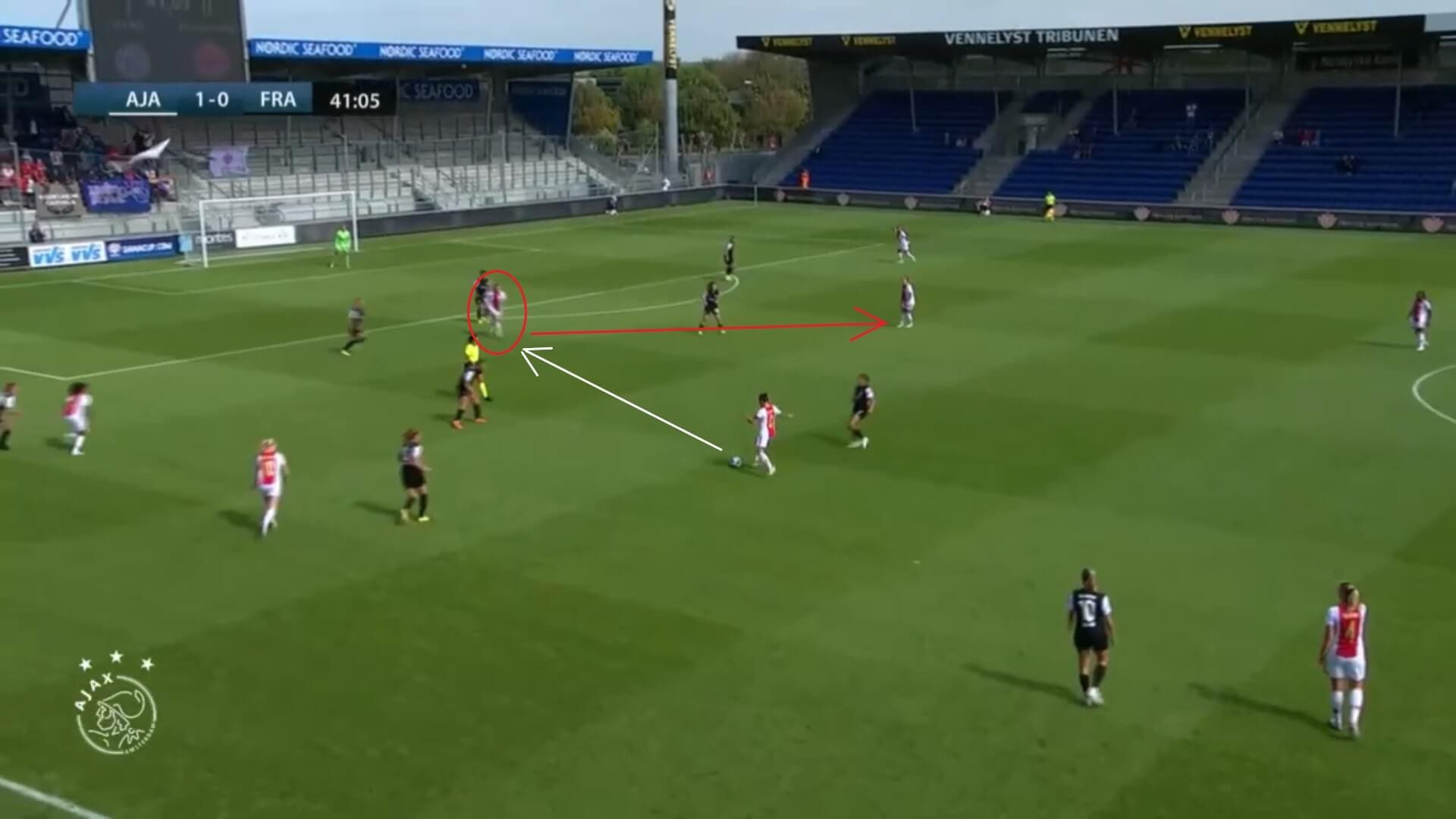
The other advantage that Ajax gained from having a target player was an ability to move the ball around the pitch, spotting and exploiting areas with less opponents and giving them a better chance of shooting at goal. In this case, Sherida Spitse has passed into Leuchter, but it is the speed and decisiveness of the striker’s pass into Victoria Pelova that opened up the chance to attack down the left-hand side, with Leuchter recognising before receiving the ball that the midfielder was in the perfect position to play the ball into a dangerous area of the pitch.
Even though the ball went backwards in order to create the opportunity, the speed and quality compensated for the temporary loss of territory, with Frankfurt again unable to react in time and Grant managing to get a shot away at goal, and the German side were at times simply unable to live with their opponents due to their fast passes and excellent teamwork.
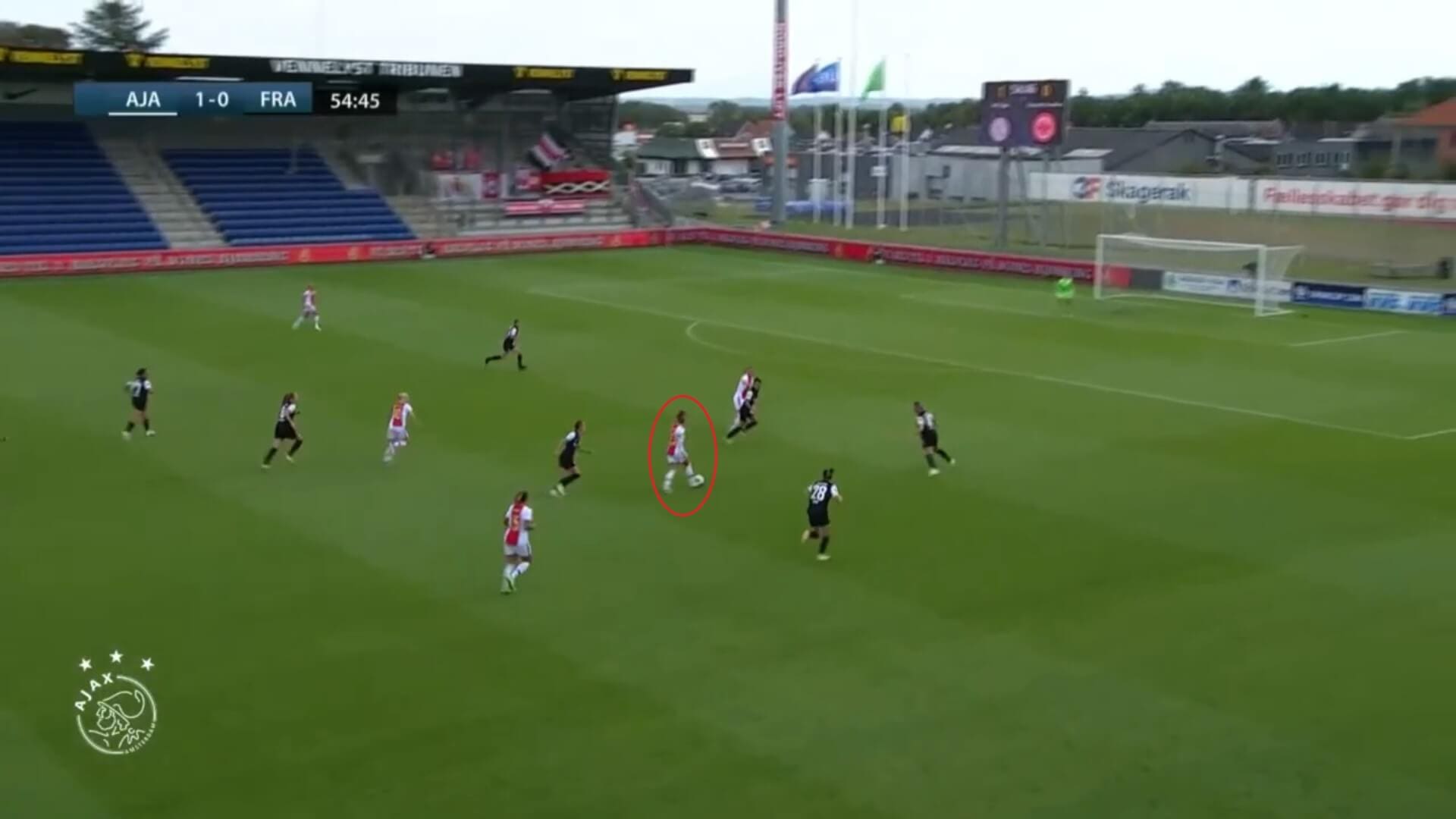
Pelova’s role in Ajax’s attack has been highlighted, and she was arguably one of their best players throughout the game, constantly finding spaces and positioning herself where she could have an effect for her team.
In this situation, she has got between Frankfurt’s midfield and defensive lines and is now looking for a teammate to pass the ball to. However, this was one of the issues that the Dutch side experienced as the match went on, with the communication and teamwork previously prominent now gone and Pelova often left with no passing options when in these areas of the pitch. Therefore, when looking at what changed between the first and second half to allow Frankfurt to get back into the game, this was one major negative point to consider.
Ajax Vrouwen’s pressing
This analysis has so far identified several different aspects of Ajax Vrouwen’s attacking play, but there was one aspect of it that was essential to them winning the match, and that was their pressing. It was clear from the first minutes that this had been something that Suzanne Bakker had drummed into her players before the game had started, knowing that keeping Eintracht Frankfurt Frauen on the back foot was essential to any hope they had of progressing, and it was undoubtedly the decisive tactic in their eventual victory.
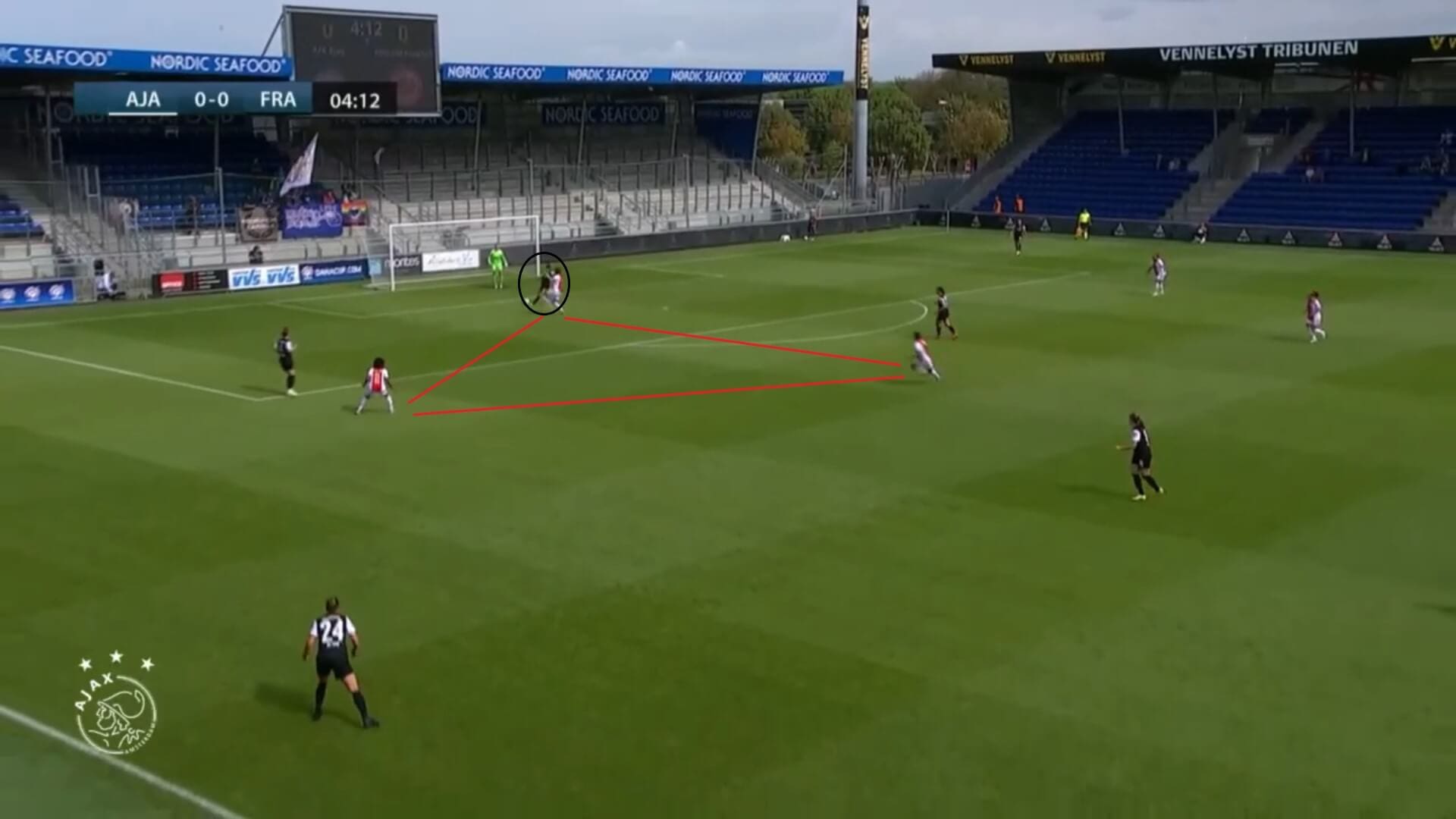
The simple point to make is that pressing led to both of the Dutch side’s goals, with this situation showing how the first was scored. In the early stages of the game, Frankfurt had been looking to play out from the back, but this only played into Ajax’s hands with their aforementioned energy and desire to get forward in numbers. As a result, it was common to see them create triangular structures such as this, meaning that one player could press, as Leuchter is doing here, whilst others could stay back and wait for the mistake to be made. In this case, it is Weerden and Sabajo who have those roles, with Weerden capitalising on the eventual loose kick from goalkeeper Cara Bösl to start a move that ended with Grant putting the ball in the back of the net.
The key to this working so successfully was the speed of movement and the anticipation of individual players, as they were constantly ready to take advantage of anything that came their way and send the ball back towards the Frankfurt goal, and having this level of threat inside their own third only added to the pressure on the German side in the first half.
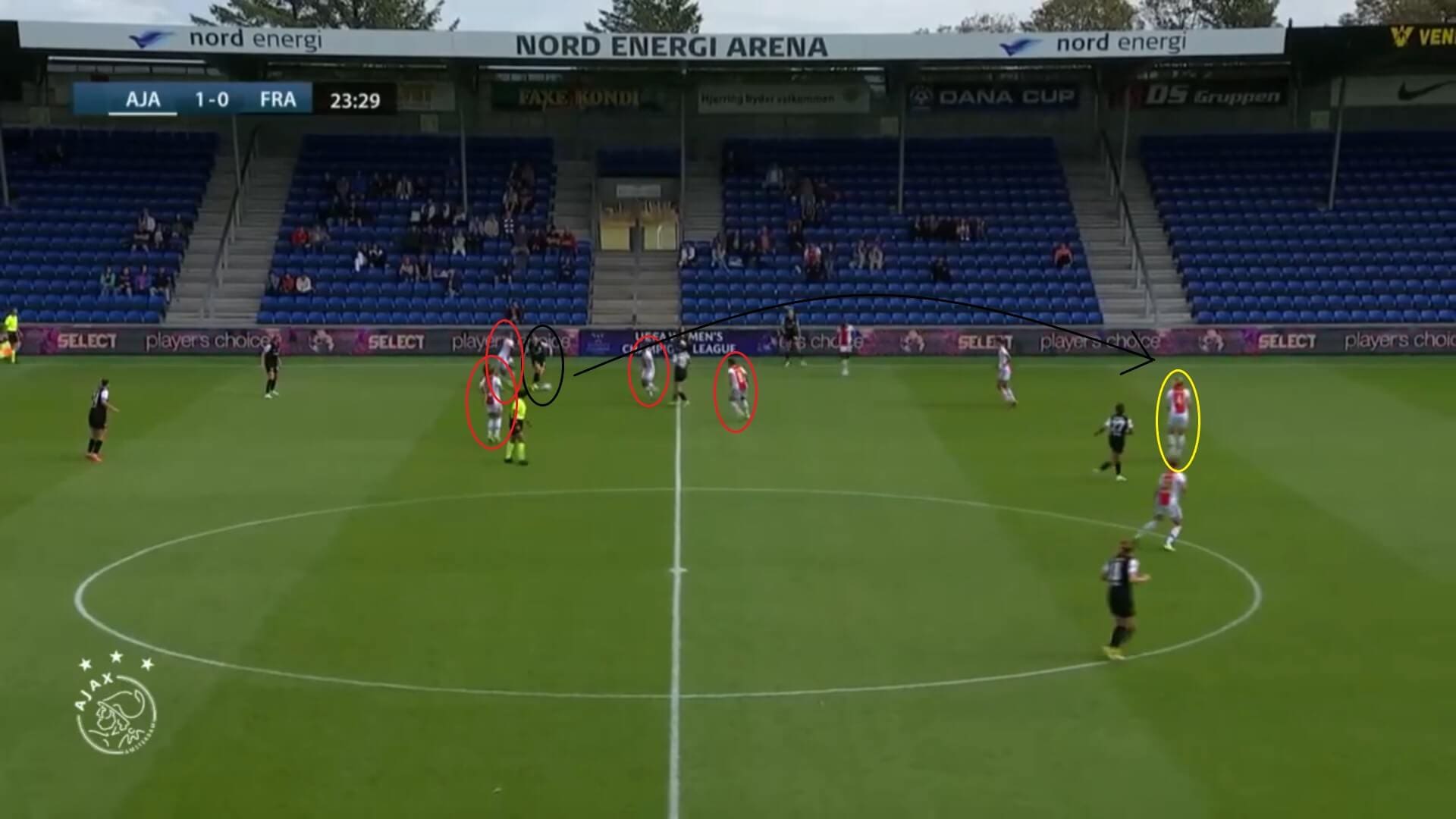
However, it wasn’t only in the final third where Ajax pressed with intensity, because they were also teaming up in other areas of the pitch to give Frankfurt as little time as possible in possession. Here, four players have worked together to surround one player near the far side line, with that detail meaning that options were already limited. However, now, there is only one possible pass to make, which is over the top and towards the Ajax defensive line, and this allows Lisa Doorn to clear the ball with ease.
Focusing on the player caught in this four-player press, it is worth mentioning that it is Lara Prašnikar, one of Frankfurt’s front two, and the fact that she has dropped so far back demonstrates how Frankfurt simply couldn’t move the ball forward due to their opponents’ strong teamwork and ability to close players down. Therefore, in order to have any hope of touching the ball in the first half, both her and Laura Freigang had to move back towards the midfield, with the negative result of this being that the German team had no presence in the final third when they did manage to transfer the ball forwards, and that was one big reason for Ajax leading at the break.
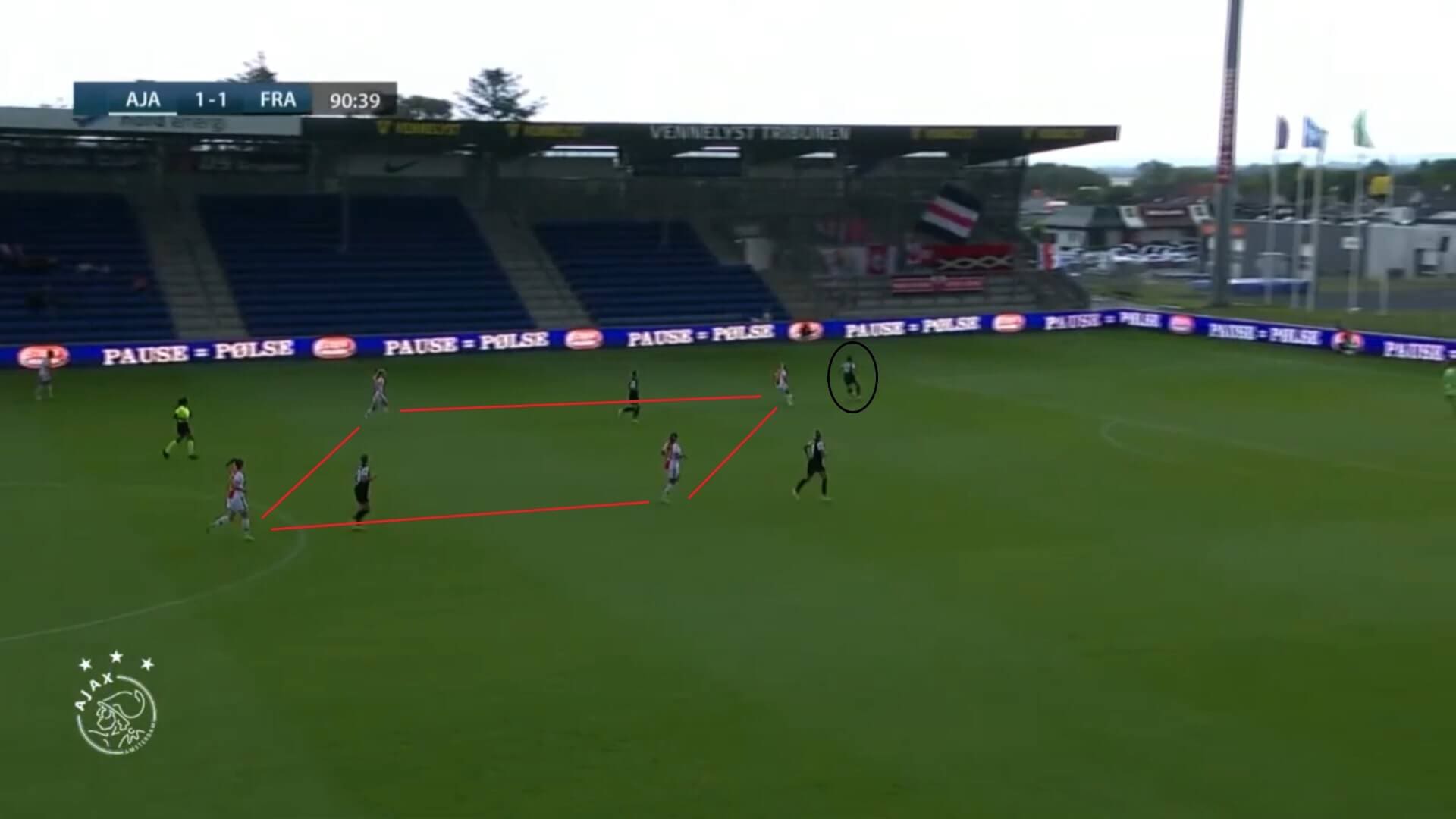
Once Frankfurt had found their feet in the second half, Ajax found it harder to press with the same intensity and instead had to resort to sitting back and preventing their opponents from accessing the space behind them, and this was one of the reasons that Frankfurt managed to level the scores and be the better team after the break.
However, in the latter stages as they looked to find a winner, the Dutch side went back to what they knew, which was the basic elements of working together and pressing from the front, and the result was that Frankfurt noticeably began to hesitate and take extra touches where they previously hadn’t been. Here, Sara Doorsoun has had to backtrack and pass towards her goalkeeper after seeing Ajax closing her down, with this resulting in a series of corners that ended in substitute Eshly Bakker scoring the winning goal, so the key point to take from this is that Ajax’s ability to regroup under pressure and revert to what had previously been working for them was what got them over the line.
Eintracht Frankfurt Frauen’s second half changes
So far, this article has broken down Ajax Vrouwen’s tactics and explained how they helped them to win the match, but it is important to note that Eintracht Frankfurt Frauen did have moments when they were on top, especially in the second half after they had made a number of tactical changes.
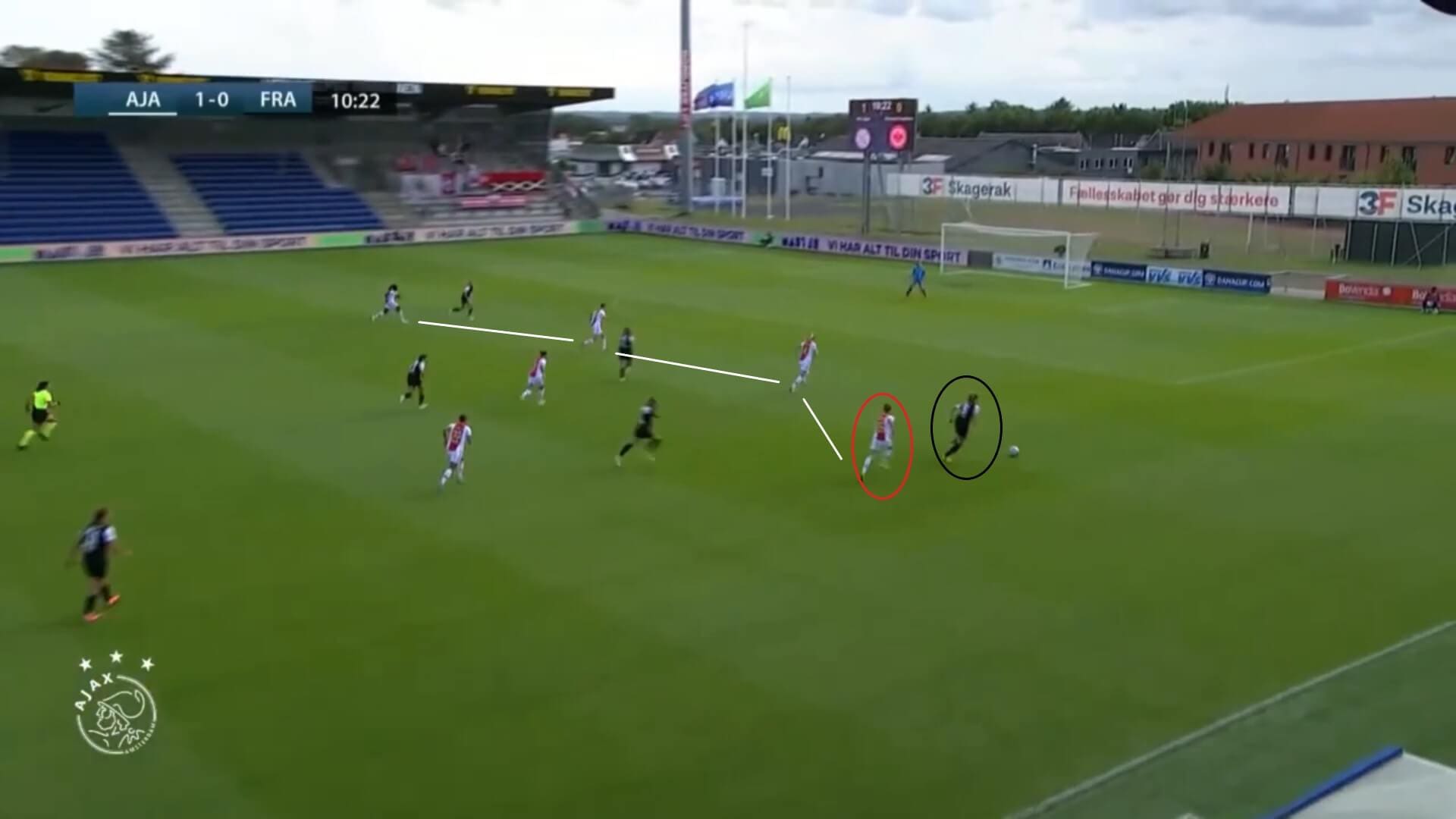
Whilst Ajax were the better side in the first half, there was one area where they had looked unsure of themselves – the left side of their defensive line. What had happened on plenty of occasions was that, in the process of trying to play out from the back, Isa Kardinaal had come out of line and then given the ball away cheaply, with the space she had left open inviting passes behind the line from the Frankfurt players as they looked to relieve some of the pressure that had been on them in the early stages. Moments like this happened on numerous occasions, with this particular example showing Sjoeke Nüsken making a run into the open space and looking to take advantage of Kardinaal’s latest mistake.
The downside of playing this way was the lack of attacking presence that has already been mentioned, with Prašnikar and Freigang not in a position to run forward and get on the end of the passes from these areas, and these chances were often wasted as a result.

However, it was clearly something that they had identified as working for them and they persevered with it in the second half, even altering their tactics to make it easier for them to attack these spaces and keep Ajax’s full-backs permanently on the back foot. Austria left-back Verena Hanshaw was arguably one of Frankfurt’s most dangerous players after the break with her runs up the field, showing the same offensive instinct that we saw from her at Euro 2022, and it became increasingly evident that Liza van der Most couldn’t live with her, whilst Kardinaal had been withdrawn at half-time due to Ajax needing to shore up that area of the team, with Weerden filling in.
In order for this to work though, there had to be more defensive protection in the full-back areas, otherwise Ajax could have simply done the same thing and played balls in behind Hanshaw and Anna Aehling. However, when the Dutch side did attempt this, both Doorsoun and Kleinherne worked hard to cover the ground and win the ball, meaning that Ajax were never able to turn those chances into anything more than that. As a result, Aehling and Hanshaw could both stay high up the field and support attacks, giving their team a better chance of scoring and, as it appeared at this point, winning the game.
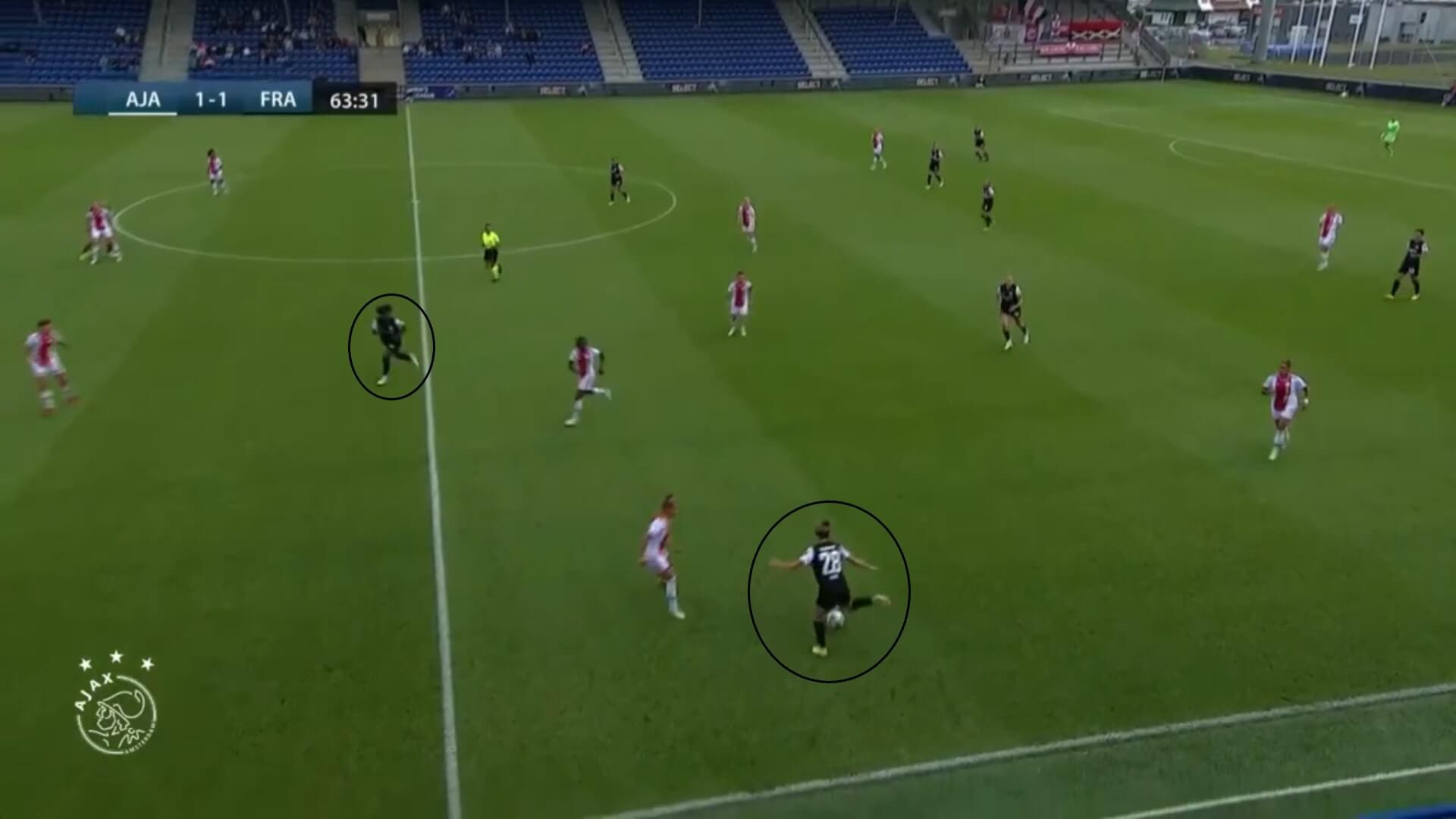
The other changes came in attack, with Germany forward Nicole Anyomi introduced at the start of the second half to solve the issue of no runs being made behind the Ajax defenders. With her on the field, Frankfurt instantly had more pace and intensity in their play, with Anyomi chasing balls down and adding everything that had been missing in their final third play up until that point, and it was her desire to win possession high up the pitch that led to the equalising goal, with Ajax goalkeeper Liza Kop leaving Prašnikar with an open goal to put the ball into.
Anyomi’s arrival also had a positive impact on her teammates, with Austria international Barbara Dunst looking more creative and having more freedom to get into dangerous areas, and her increased confidence saw her take on opponents in 1-v-1 duels and prove to be a bigger handful than she had been in the first half. These are her main qualities and are what she brings to the team, but she had been quiet in the first half due to Frankfurt’s inability to work their opponents out. Her individual improvement was another sign that what Frankfurt had changed at the break was working for them, with Dunst having several opportunities to get on the scoresheet and unlucky not to be when the full-time whistle was blown.
Conclusion
In conclusion, this tactical analysis has looked in detail at the Women’s Champions League match between Ajax Vrouwen and Eintracht Frankfurt Frauen, seeing why Ajax took the win despite Frankfurt having more chances to score in total. How the German side lost this one will be something that they will need to work out when they go back over their performance, but they can be pleased with their second half reaction and the fact that their changes did have the desired effect.
However, Ajax will be very happy to have negotiated this very tricky first qualifying round and have put their name in the hat for the next stage, with Eshly Bakker highlighting afterwards how their ability to keep fighting was what got them through. There is now just a two-legged tie between them and a place in the group stages, but they will know that there are things that need improving if they want to have a chance of getting that far.
The Dutch side’s next game is a friendly against Köln Frauen, before their domestic campaign begins with a home game against Fortuna Sittard Vrouwen. Frankfurt, meanwhile, will now have no game until 16 September, when the Frauen Bundesliga season gets underway and they host Bayern Munich Frauen.





Comments